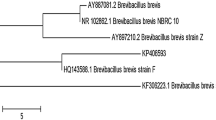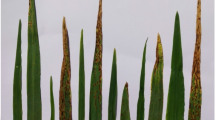Abstract
Present study was carried out to appraise various biochemical and metabolic changes during spot blotch disease development and efficiency of two plant growth promoting rhizobacterial (PGPR) strains Bacillus safensis W10 and Ochrobactrum pseudogrignonense IP8 in promoting resistance against Bipolaris sorokiniana. In PGPR primed plants which were challenge inoculated with B. sorokiniana, disease index reduced markedly, which was about 50% in B. safensis treatment and 40% in O. pseudogrignonense. Application of PGPR decreased stress indicators like hydrogen peroxide and malonaldehyde accumulated in infected plant tissue as a response to oxidative damage promoted by lipid peroxidation under elevated free radical formation. Increased activity of defense enzymes such as, chitinase, β-1,3 glucanase, phenyl alanine ammonia lyase and peroxidase were observed in plants following application with PGPR and challenge inoculated with B. sorokiniana in comparison with untreated healthy control plants. Besides, accumulation of proline and biochemical components such as total soluble protein and total phenol in higher concentration in PGPR treated and pathogen inoculated plants was evident. Analysis of phenols by high performance liquid chromatography revealed higher accumulation of phenols such as ferulic acid, salicylic acid and caffeic acid.





Similar content being viewed by others
References
Abdullah AS, Moffat CS, Lopez-Ruiz FJ, Gibberd MR, Hamblin J, Zerihun A (2017) Host–multi-pathogen warfare: pathogen interactions in co-infected plants. Front Plant Sci 8:1806. https://doi.org/10.3389/fpls.2017.01806
Abeysingha NS, Singh M, Islam A, Sehgal VK (2016) Climate change impacts on irrigated rice and wheat production in Gomti River basin of India: a case study. SpringerPlus 5:1250. https://doi.org/10.1186/s40064-016-2905-y
Adlakha KI, Wilcoxson RD, Raychaudhary SP (1984) Resistance of wheat to leaf spot caused by Bipolaris sorokiniana. Plant Dis 68:320–321
Anand T, Chandrasekaran A, Kuttalam S, Raguchander T, Prakasam V, Samiyappan R (2007) Association of some plant defense enzyme activities with systemic resistance to early leaf blight and leaf spot induced in tomato plants by azoxystrobin and Pseudomonas fluorescens. J Plant Interact 2(4):233–244
Armijo G, Schlechter R, Agurto M, Munoz D, Nunez C, Arce-Johnson P (2016) Grapevine pathogenic microorganisms: understanding infection strategies and host response scenarios. Front Plant Sci 7:382
Bent E (2006) Induced systemic resistance mediated by plant growth-promoting rhizobacteria (PGPR) and fungi (PGPF). In: Tuzun S, Bent E (eds) Multigenic and induced systemic resistance in plants. Springer, New York, pp 225–258
Boller T, Mauch F (1988) Colorimetric assay for chitinase. Methods Enzymol 161:430–435
Boominathan U, Sivakumaar Palanivel K (2013) Bacillus megaterium (AUM72)—mediated induction of defense related enzymes to enhance the resistance of turmeric (Curcuma longa L.) to Pythium aphanidermatum causing rhizome rot. Agricultura 10:1–8
Boyd LA, Ridout C, O’Sullivan DM, Leach JE, Leung H (2013) Plant pathogen interactions: disease resistance in modern agriculture. Trends Genet 29:233–240
Caverzan A, Passaia G, Rosa SB, Ribeiro CW, Lazzarotto F, Pinheiro MM (2012) Plant responses to stresses: role of ascorbate peroxidase in the antioxidant protection. Genet Mol Biol 35(4 Suppl):1011–1019
Chakraborty BN, Chakraborty U (2017) Induced immunity in plants using bioinoculants and biostimulants. In: Pandey RN, Chakraborty BN, Singh D, Sharma P (eds) Microbial antagonists: role in biological control of plant diseases. Indian Phytopathological Society, New Delhi, pp 607–627
Chakraborty U, Chakraborty BN, Kapoor M (1993) Changes in the levels of peroxidase and phenyl alanine ammonia lyase in Brassica napus cultivars showing variable resistance to Leptosphaeria maculans. Folia Microbiol 38:491–496
Chakraborty U, Chakraborty BN, Chakraborty AP, Dey PL (2013) Water stress amelioration and plant growth promotion in wheat plants by osmotic stress tolerant bacteria. World J Microbiol Biotechnol 29:789–803
Chakraborty U, Chakraborty BN, Chakraborty AP, Sunar K, Dey PL (2014) Plant growth promoting rhizobacteria: diversity, mechanisms of action and perspectives in agriculture. Rev Plant Pathol 6:215–268
Chakraborty BN, Chakraborty U, Chakraborty AP, Sashankar P (2016a) Serological and molecular detection of Bipolaris sorokiniana Sacc. causing spot blotch disease of wheat. J Mycol Pathol Res 54(1):117–126
Chakraborty U, Chakraborty BN, Chakraborty AP, De UK (2016b) Resistance in tea plants against root rot pathogens induced by arbuscular mycorrhizal fungi and plant growth promoters. J Mycopathol Res 54:211–224
Chowdhury AK, Bhattacharya PM, Singh G (2014) Foliar blight: the major biotic constraint of wheat in rice–wheat systems of Eastern Gangetic plains. Rev Plant Pathol 6:437–472
Gaiero JR, McCall CA, Thompson KA, Day NJ, Best AS, Dunfield KE (2013) Inside the root microbiome: bacterial root endophytes and plant growth promotion. Am J Bot 100(9):1738–1750. https://doi.org/10.3732/ajb.1200572
Glick BR, Todorovic B, Czarny J, Cheng Z, Duan J, McConkey B (2007) Promotion of plant growth by bacterial ACC deaminase. Crit Rev Plant Sci 26:227–242
Gupta G, Parihar SS, Ahirwar NK, Snehi SK, Singh V (2015) Plant growth promoting rhizobacteria (PGPR): current and future prospects for development of sustainable agriculture. J Microb Biochem Technol 7:2
Hammond-Kosack KE, Jones JDG (1996) Resistance gene dependent plant defense responses. Plant Cell 8:1773–1791
Heath RL, Packer L (1968) Photoperoxidation in isolated chloroplasts: kinetics and stoichiometry of fatty acid peroxidation. Arch Biochem Biophys 125:189–198
Hemm MR, Rider SD, Ogas J, Murry DJ, Chapple C (2004) Light induces phenylpropanoid metabolism in Arabidopsis roots. Plant J 38:765–778
Hossain MM, Sultana F, Islam S (2017) Plant growth-promoting fungi (PGPF): phytostimulation and induced systemic resistance. In: Singh D, Singh H, Prabha R (eds) Plant–microbe interactions in agro-ecological perspectives. Springer, Singapore, pp 135–191
Jayaraj J, Bhuvaneswari R, Rabindran R, Muthukrishnan S, Velazhahan R (2010) Oxalic acid-induced resistance to Rhizoctonia solani in rice is associated with induction of phenolics, peroxidase and pathogenesis-related proteins. J Plant Interact 5:147–157
Jena S, Choudhuri MA (1981) Glycolate metabolism of three submerged aquatic angiosperms during aging. Aquat Bot 12:345–354
Joshi AK, Kumari M, Singh VP, Reddy CM, Kumar S, Rane J, Chand R (2007) Stay green trait: variation, inheritance and its association with spot blotch resistance in spring wheat (Triticum aestivum L.). Euphytica 153:59–71
Lamb C, Dixon RA (1997) The oxidative burst in plant disease resistance. Annu Rev Plant Physiol Plant Mol Biol 48:251–275
Levine A, Tenhaken R, Dixon R, Lamb CJ (1994) H2O2 from the oxidative burst orchestrates the plant hypersensitive disease resistance response. Cell 79:583–593
Lowry OH, Rosebrough NJ, Fair AL, Randall RJ (1951) Protein measurements with folin phenol reagent. J Biol Chem 193:265–275
Mahadevan A, Sridhar R (1982) Methods in physiological plant pathology, 2nd edn. Sivakami Publication, Madras, India, p 316
Maksimov I, Troshina N, Surina O, Cherepanova E (2014) Salicylic acid increases the defense reaction against bunt and smut pathogens in wheat calli. J Plant Interact 9:306–314
Montillet JL, Chamnongpol S, Rusterucci C, Dat J, van de Cotte B, Agnel JP, Battesti C, Inze D, Van Breusegem F, Triantaphylides C (2005) Fatty acid hydroperoxides and H2O2 in the execution of hypersensitive cell death in tobacco leaves. Plant Physiol 138:1516–1526
Nicholson RL, Hammerschmidt R (1992) Phenolic compounds and their role in disease resistance. Annu Rev Phytopathol 30:369–389
Orozco-Cárdenas ML, Nárvaez-Vásquez J, Ryan CA (2001) Hydrogen peroxide acts as a second messenger for the induction of defense genes in tomato plants in response to wounding, systemin and methyl jasmonate. Plant Cell 13:179–191
Pan SQ, Ye XS, Kue J (1991) A technique for detection of chitinase, β-1,3-glucanase and protein patterns after a single separation using polyacrylamide gel electrophoresis and isoelectric focusing. Phytopathology 81:970–974
Pari L, Karamac M, Kosinska A, Rybarczyk A, Amarowicz R (2007) Antioxidant activity of the crude extracts of drumstick tree (Moringa oleifera Lam.) and sweet broomweed (Scoparia dulcis L.) leaves. Polish J Food Nu Sc 57(2):203–208
Savary S, Nelson A, Sparks AH, Willocquet L, Duveiller E, Mahuku G, Forbes G, Garrett K, Hodson D, Padgham J, Pande S, Sharma S, Yuen J, Djurle A (2011) International agricultural research tackling the effects of global and climate changes on plant diseases in the developing world. Plant Dis 95(10):1204–1216
Shamim I, Shahzad A, Anjum M, Iftikhar A (2008) Selection of in vitro technique for pathogenicity and screening of wheat cultivars against Bipolaris sorokiniana. Pak J Bot 40:415–420
Sivasakthi S, Usharani G, Saranraj P (2014) Biocontrol potentiality of plant growth promoting bacteria (PGPR)—Pseudomonas fluorescens and Bacillus subtilis: a review. Afr J Agric Res 9:1265–1277
Tahsili J, Sharifi M, Safaie N, Esmaeilzadeh-Bahabadi S, Behmanesh M (2014) Induction of lignans and phenolic compounds in cell culture of Linum album by culture filtrate of Fusarium graminearum. J Plant Interact 9:412–417
Thordal-Christensen H, Zhang Z, Wei Y, Collinge DB (1997) Subcellular localization of H2O2 in plants, H2O2 accumulation in papillae and hypersensitive response during barley–powdery mildew interaction. Plant J 11:1187–1194
Torres MA, Jones DGJ, Dangl JL (2006) Reactive oxygen species signaling in response to pathogens. Plant Physiol 141(2):373–378
Tripathi A, Aggarwal R, Yadav A (2013) Differential expression analysis of defense-related genes responsive to Tilletia indica infection in wheat. Turk J Biol 37:606–613
Villareal RL, del Toro E, Mujeeb-Kazi A, Rajaram S (1995) The 1BL/1RS chromosome translocation effect on yield characteristics in a Triticum aestivum L. cross. Plant Breed 114:497–500
Yoshida K, Kaothien P, Matsui T, Kawaoka A, Shinmyo A (2003) Molecular biology and application of plant peroxidase genes. Appl Microbiol Biotechnol 60:665–670
Zlatev ZS, Lidon FC, Ramalho JC, Yordanov IT (2006) Comparison of resistance to drought of three bean cultivars. Biol Plant 50:389–394
Acknowledgements
Financial help received from Department of Science and Technology, Govt. of India, under Inspire fellowship to JS is gratefully acknowledged.
Author information
Authors and Affiliations
Corresponding author
Rights and permissions
About this article
Cite this article
Sarkar, J., Chakraborty, U. & Chakraborty, B.N. Induced defense response in wheat plants against Bipolaris sorokiniana following application of Bacillus safensis and Ochrobactrum pseudogrignonense. Indian Phytopathology 71, 49–58 (2018). https://doi.org/10.1007/s42360-018-0006-2
Received:
Accepted:
Published:
Issue Date:
DOI: https://doi.org/10.1007/s42360-018-0006-2




